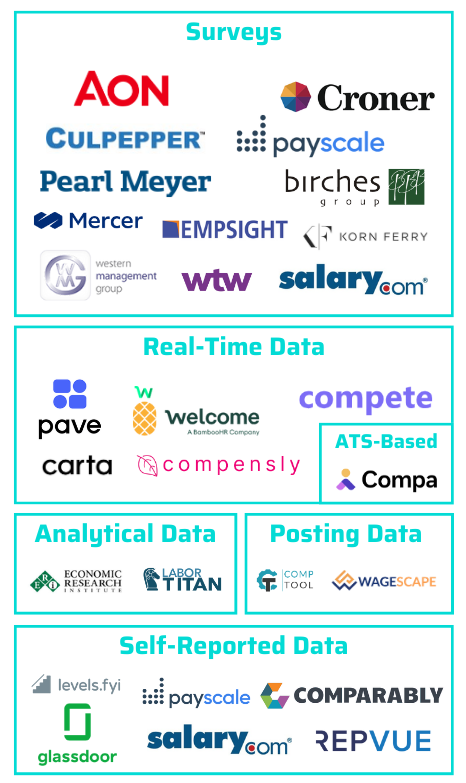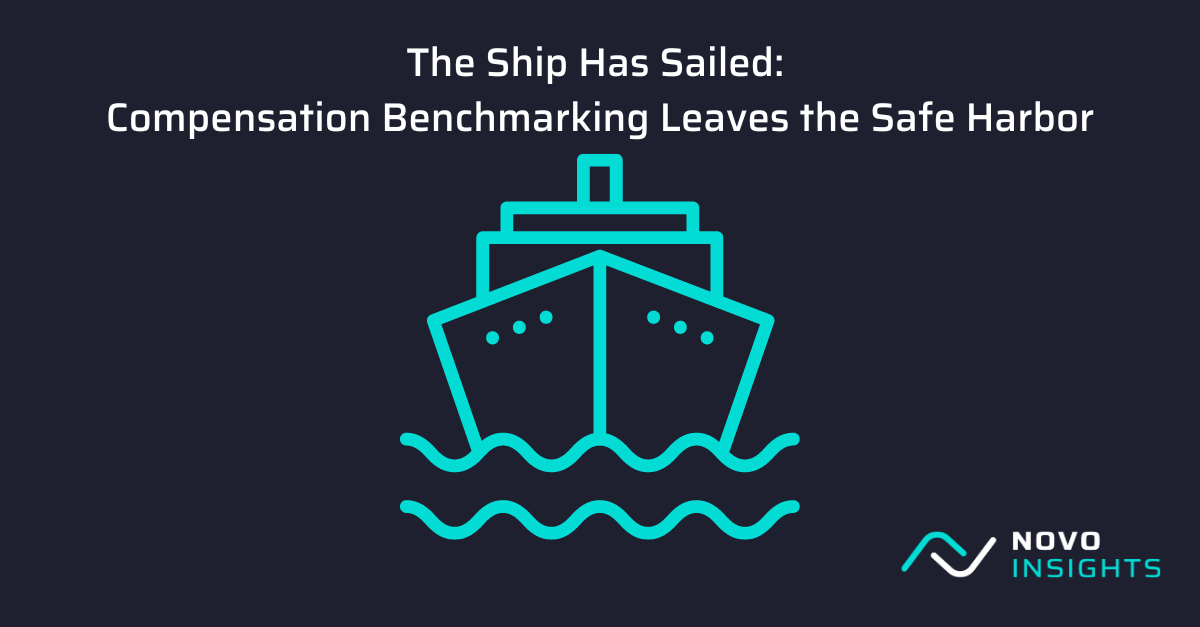Around half of compensation professionals are concerned about the legality of "real-time" benchmarking data. While it's prudent to show concern, we find that most concerns are rooted in an incomplete view of current regulation and how that regulation may change.
In a recent LinkedIn poll, around half of respondents cited they are "Very Concerned" or "Slightly Concerned" about the legality of real-time market compensation benchmarks. Real-Time Data is a specific category of market data, where benchmarks are created through a live integration with HR data and shared more regularly with those submitting the data.
Market Data Categories: October 2023 Version

What is Driving the Degree of Concern?
Compensation professionals have long been trained to ensure that compensation benchmarking practices follow Federal Trade Commission guidance on antitrust matters. These guidelines largely stem from antitrust inquiries into the healthcare market in the mid-1990s, where specific "safety zones" - or Safe Harbors - were articulated to define practices that make information sharing among competitors less likely to harm competition:
- Survey managed by a third-party
- Information provided by survey participants is based on data at least 3 months old
- At least five organizations represented in a benchmark
- No individual provider represents more than 25% of that benchmark population
- Benchmarks and statistics are sufficiently aggregated to not allow identifying the contribution of any particular organization
The emphasis on age is largely what is driving concern about Real-Time data, since "real time" certainly implies there is no lag in the data. While some compensation professionals cite concern about the other guidelines above, the primary guideline cited as a concern is the 3-month rule.
Our view is that this should not be a driving concern.
What is a Safe Harbor?
The criteria noted above were articulated to identify a "safety zone" - or Safe Harbor - for information sharing where the FC and DOJ would not challenge participation if those conditions were met. Safe Harbors are not explicit rules for what is legal or illegal. Rather, they are standards that help clarify specific circumstances that are permissible within a more vague or judgment-based standard. There are also "Unsafe Harbors," which are more specific examples of behaviors or circumstances that will de deemed as violating a standard.
Take as an example the laws around "reckless driving" which vary quite a bit state by state. At their core, all reckless driving statutes are solving for a relatively vague but understandable standard: it's bad to drive unsafely. Using Illinois's law as an example, the law simply states a person commits reckless driving if he or she drives any vehicle with a willful or wanton disregard for the safety of persons or property. That's a relatively vague standard, though most would agree they generally know what it means. Illinois then goes on to establish a few specific "Unsafe Harbors" to clarify specific acts that will be deemed reckless: uses an incline to cause the vehicle to become airborne, or any speed exceeding 35 miles per hour over the speed limit.
While an Unsafe Harbor is a clear violation of the law, not being in a Safe Harbor does not mean you are violating the law. It simply means that your conduct will be judged against the overall standard.
How Did This Apply to Compensation Benchmarking?
The guidelines for compensation information sharing were articulated as a Safe Harbor within the broader regulation on maintaining a fair and competitive employment market. While there are a few key federal laws that apply to antitrust (The Federal Trade Commission Act, the Sherman Act, and the Clayton Act), they all essentially boil down to "don't do things that are anti-competitive." Lots of case law and refining legislation have occurred in the hundred years of antitrust practice, and ultimately they are all interpretations of whether an act crossed a line of anticompetitiveness.
We believe that real-time data may not be within the Safe Harbor, and thus the creation and usage of such data will need to be assessed relative to the broader set of antitrust regulation.
The ship has sailed from the Safe Harbor.
Does This Mean We're Now Breaking the Law?
Absolutely not.
The purpose of using a Safe Harbor standard of rulemaking is to add clarity when possible, but it does not establish that acts and behaviors not enumerated are thus illegal. Rather, it simply means that the facts and circumstances of a given case would determine if anticompetitive behavior existed.
We argue that the existence of a compensation benchmark does not degrade competition or harm workers. There's evidence that additional transparency around the market for executive talent actually increased competition and wage rates for executive talent.
If a retail store hangs a sign that says they are hiring with a starting wage of $15, that's a benchmark. Should another store, who currently pays $14 to start, choose to raise their starting wage to $15 on the basis of seeing that sign, that's a positive for workers. If another store, currently paying $25, chooses to lower their rate of pay based on seeing the sign, that's a business decision and risk associated with how they compete.
Of course, the line gets crossed if specific competitors agree to always pay what is reported as a median - that agreement stifles competition. Awareness of practices in itself should not be deemed anticompetitive. Choosing to fix wages clearly is.
Is the Ship Sailing A Good or Bad Thing for Compensation Professionals?
Our view is that taking a fresh look at how compensation levels are benchmarked is bringing needed innovation to the table. For a long time, compensation professionals struggled with the pace of compensation benchmarking: data was by definition "old," new types of work would take a year or two to be added to surveys and have meaningful data, and the cost of participation and analysis was very high. New forms of data have eliminated those challenges, though with other complicating factors and/or simplifying assumptions. For example, most real-time providers have simpler approaches to matching jobs, whereas traditional compensation surveys have deeper methodologies for identifying distinct roles. Having more choice around the data used to measure competitiveness is a good thing - not a risk.
Conclusion
Real-time data creates a new opportunity for compensation professionals to understand how their compensation program compares to market. Compensation teams can carefully consider how various lenses of the market help them best estimate the cost of labor, which can inform how their organization attracts and retains the talent needed for business success.
Disclaimer: Novo Insights LLC is not a law firm, and this post should be viewed as an opinion and not legal advice.



